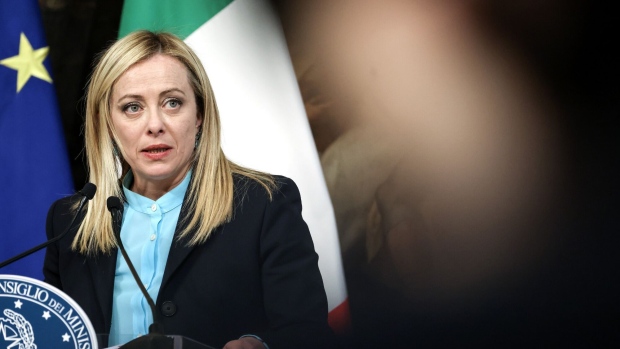Nov 3, 2023
Toxic Cycle of 70 Governments in 75 Years Is Meloni’s New Target
, Bloomberg News

(Bloomberg) -- Prime Minister Giorgia Meloni kicked off an attempt to rid Italy of revolving-door governments, but critics fear the constitutional change she wants could make things worse.
Meloni’s right-wing government backed a draft law Friday to change the constitution so that Italians would vote directly for their prime minister, and boosting the premier’s power at the expense of the president’s, according to a text seen by Bloomberg.
“This reform will guarantee the right of Italian citizens to choose who will be the premier, putting an end to reversals, palace intrigues” and so-called technocrats serving as prime minister instead of politicians, Meloni told reporters. The change “will guarantee that who has been chosen will govern enjoying political stability.”
Stability is a traditional concern for Italy’s partners and for investors, in a country which has seen almost 70 governments in just over 75 years. That’s been the price to pay for a system born after the fall of Benito Mussolini’s fascist regime, and designed with checks and balances to prevent the emergence of another authoritarian figure.
The draft law is however short on specifics. It does not detail which electoral law would be applied, nor does it explain what would happen if a government loses parliamentary support. That has triggered concern among constitutional experts that the change could make Italy even more unstable. The process could be difficult for Meloni to push through.
Here is a guide to the reform:
What does Meloni want to change?
Today, Italians elect lawmakers to parliament and the biggest political party, or the biggest coalition, recommends a candidate for the job of prime minister, who is ultimately appointed by the president. The premier-designate picks the ministers, who are also vetted by the president. The new government takes power if it wins a parliamentary vote of confidence.
Meloni’s draft law would change four articles of the constitution. Italians would vote at the same time for both the prime minister and parliament. The president’s powers to dissolve parliament and to appoint the premier would also be overhauled.
The extent to which Italy’s president would lose his or her powers is still unclear. While the president mostly has a ceremonial role, he or she is powerful at times of tensions between parties and can appoint a so-called technocrat as premier. This happened as recently as 2021, when President Sergio Mattarella named Mario Draghi, former head of the European Central Bank.
What would Italy gain from the reform?
The reform’s backers argue that the change would mean elections result in a clear winner for the premiership, instead of the wheeler-dealing that lasts for weeks and sees parties jostle with each other for the top job.
Supporters say the premier’s direct mandate from voters would give him or her greater legitimacy — especially given the appointment of technocrats when politicians were stalled — and shrink the need for long negotiations between weak, fractious coalition parties on a new government’s program.
Investors have long worried about Italy’s political volatility, but markets are not yet factoring in upcoming changes which are perceived as taking years to implement. Instead, investors are focusing on how new European Union fiscal rules will affect Italy, upcoming ratings decisions, and the country’s economic outlook.
For Meloni, the proposal is an attempt to project her as championing the rights of voters against a system she has long denounced as elitist. Her coalition partners, the anti-migrant League and the center-right Forza Italia, both back her plan.
What are the risks for Italy?
Dysfunction. Constitutional experts say the reform may bring more instability as it mixes parts of foreign models and lacks details on how the political system would work in practice.
“The proposal is unclear, confused and a bit rigid,” said Francesco Clementi, a professor of constitutional law at La Sapienza university in Rome. “Even if voters can elect the prime minister directly, he or she could be very easily lose power, making his power even less solid.”
“The proposal includes the direct election of the prime minister, but there are no details on how that would happen, whether with one or two ballots,” said Sofia Ventura, a professor of political sciences at the University of Bologna. “The direct election of the leader is not a one-shop solution to Italy’s instability.”
What are the actual chances of the change happening?
Expectations are that the plan will be modified in future, and there is even no guarantee Meloni will manage to push it through.
The process is lengthy and it requires two votes of approval from each house of parliament and a possible referendum. “I hope these measures will be met with a large consensus in parliament,” Meloni said. “Should this not happen, we will ask Italians how they feel about this in a referendum.”
The change would also be subject to backing from Italy’s Constitutional Court.
--With assistance from Giovanni Salzano and James Hirai.
(Updates with Meloni’s remarks from third paragraph)
©2023 Bloomberg L.P.








